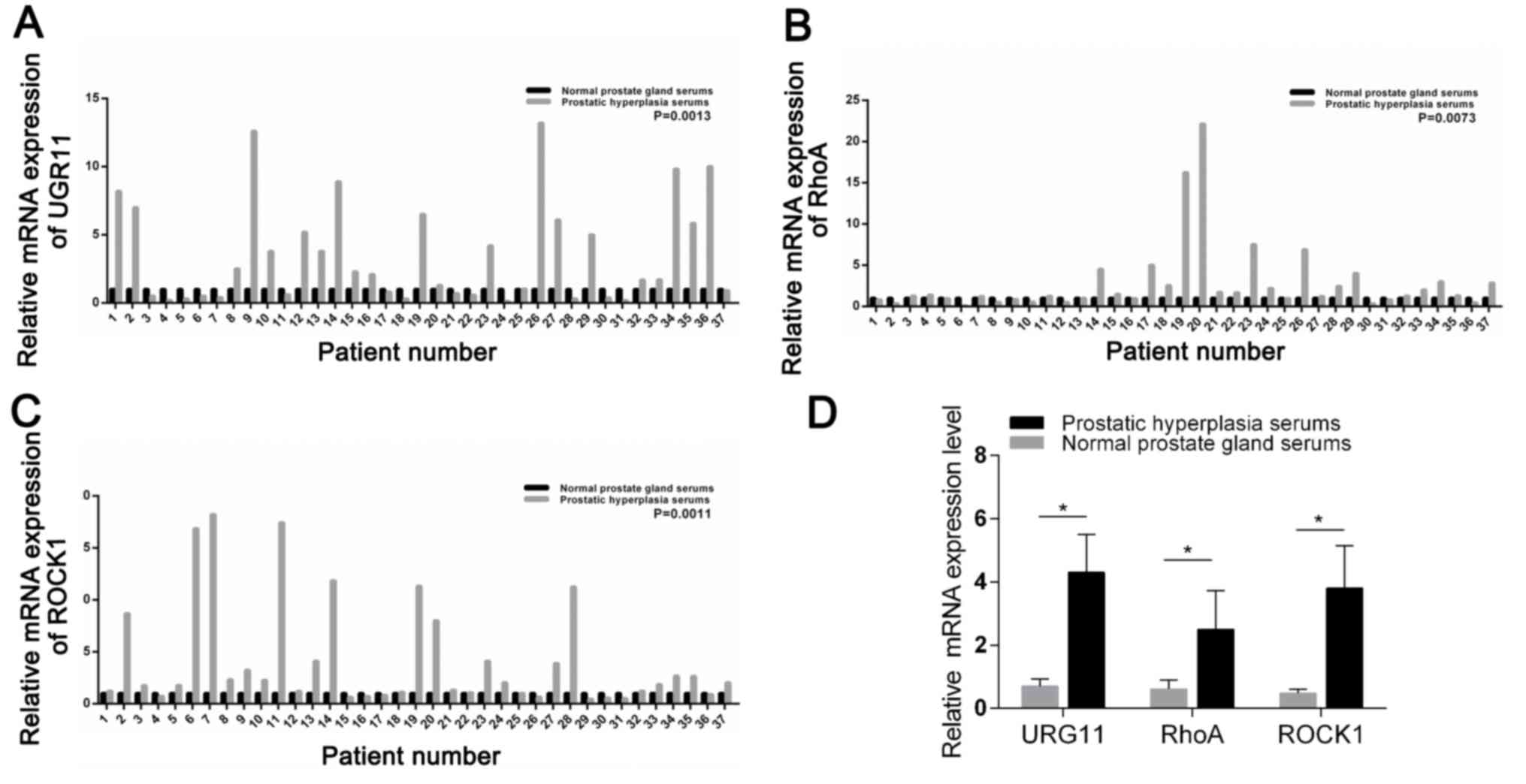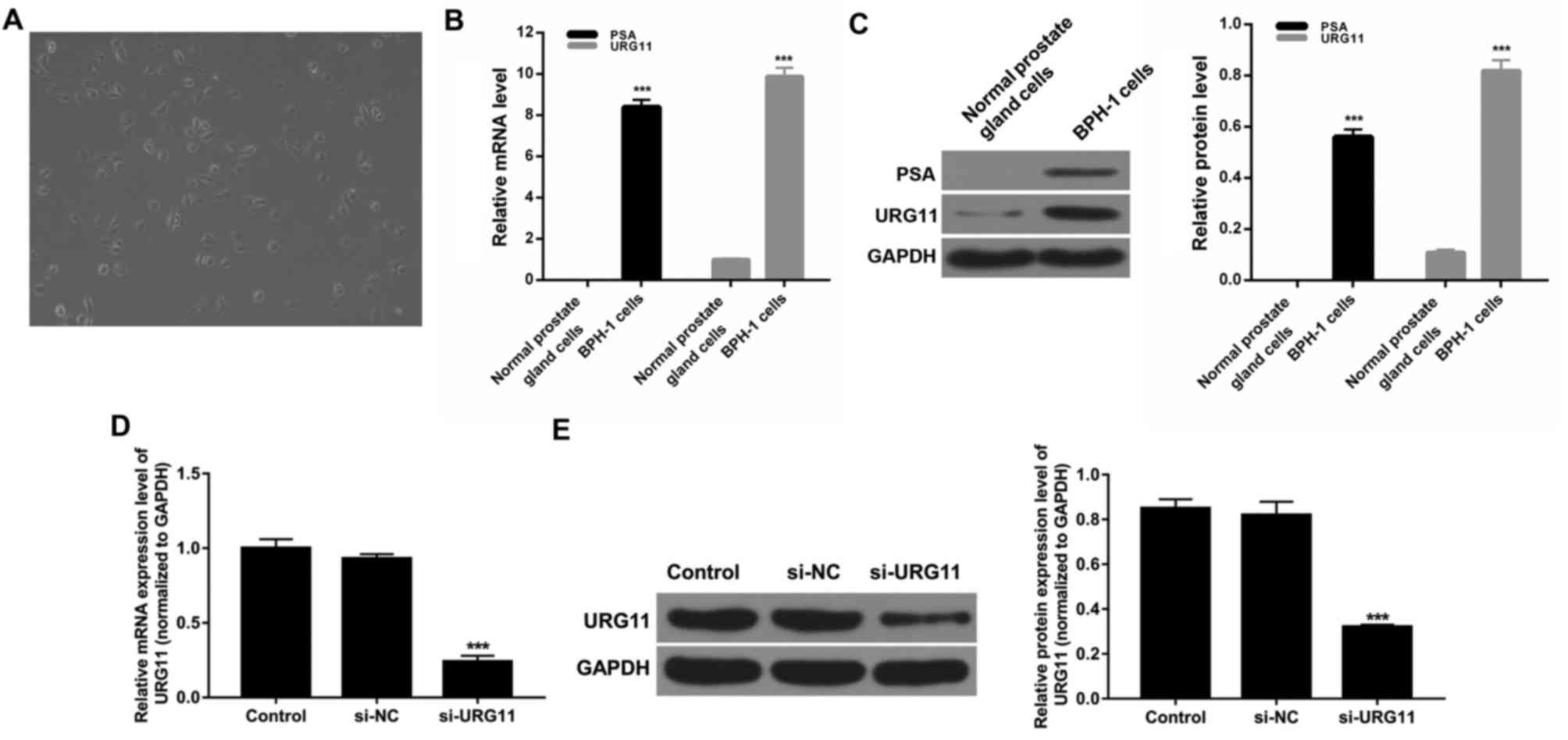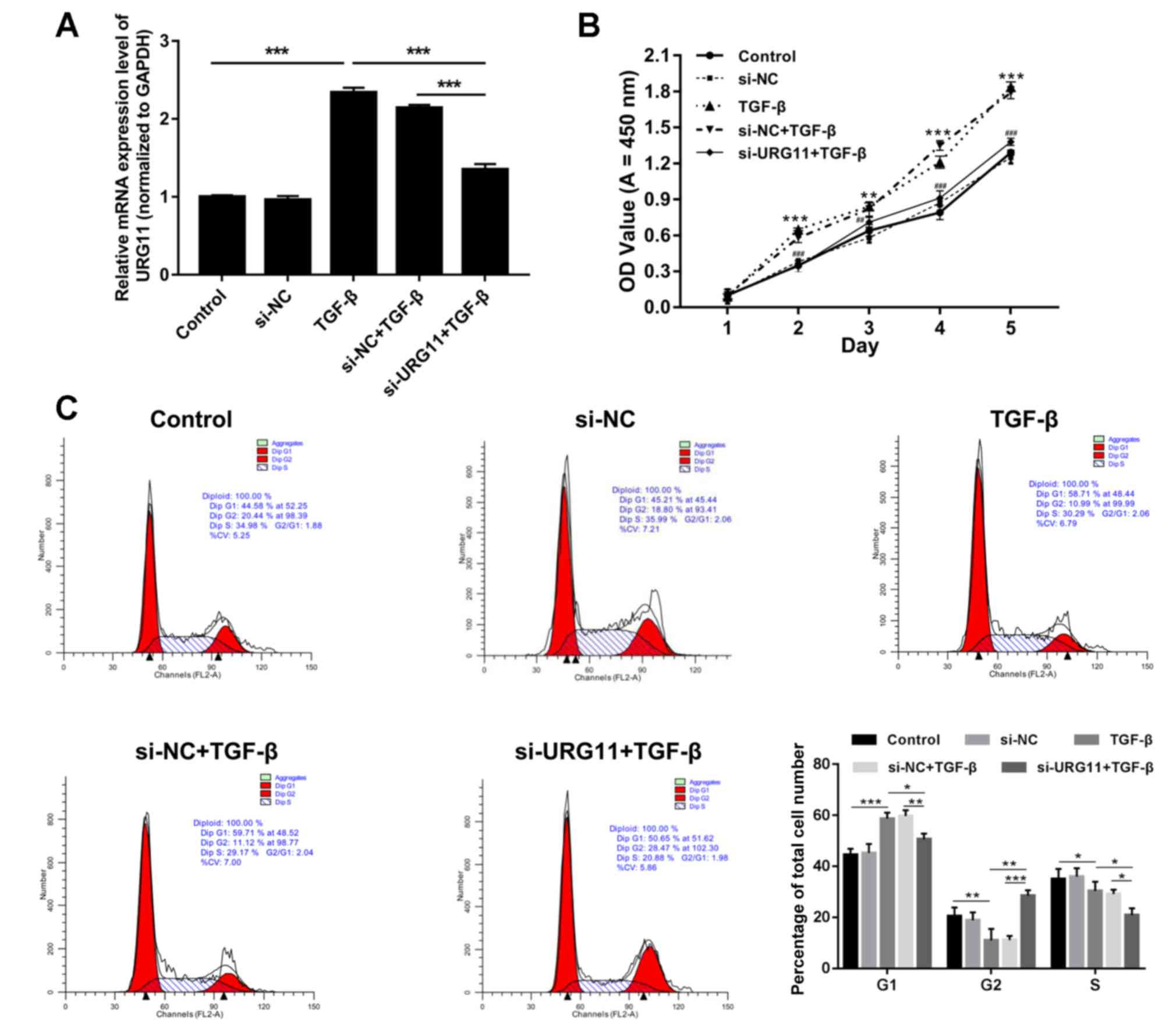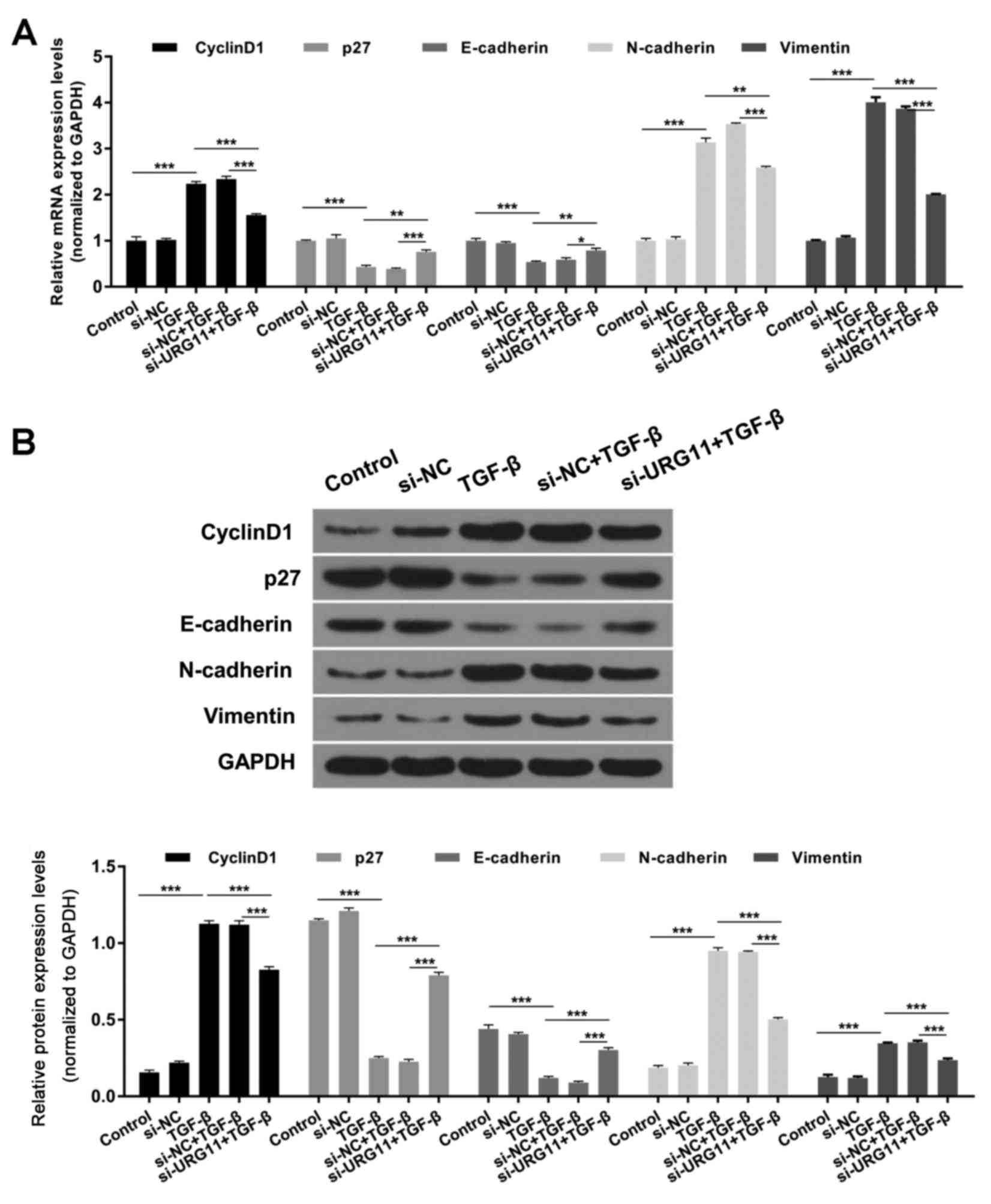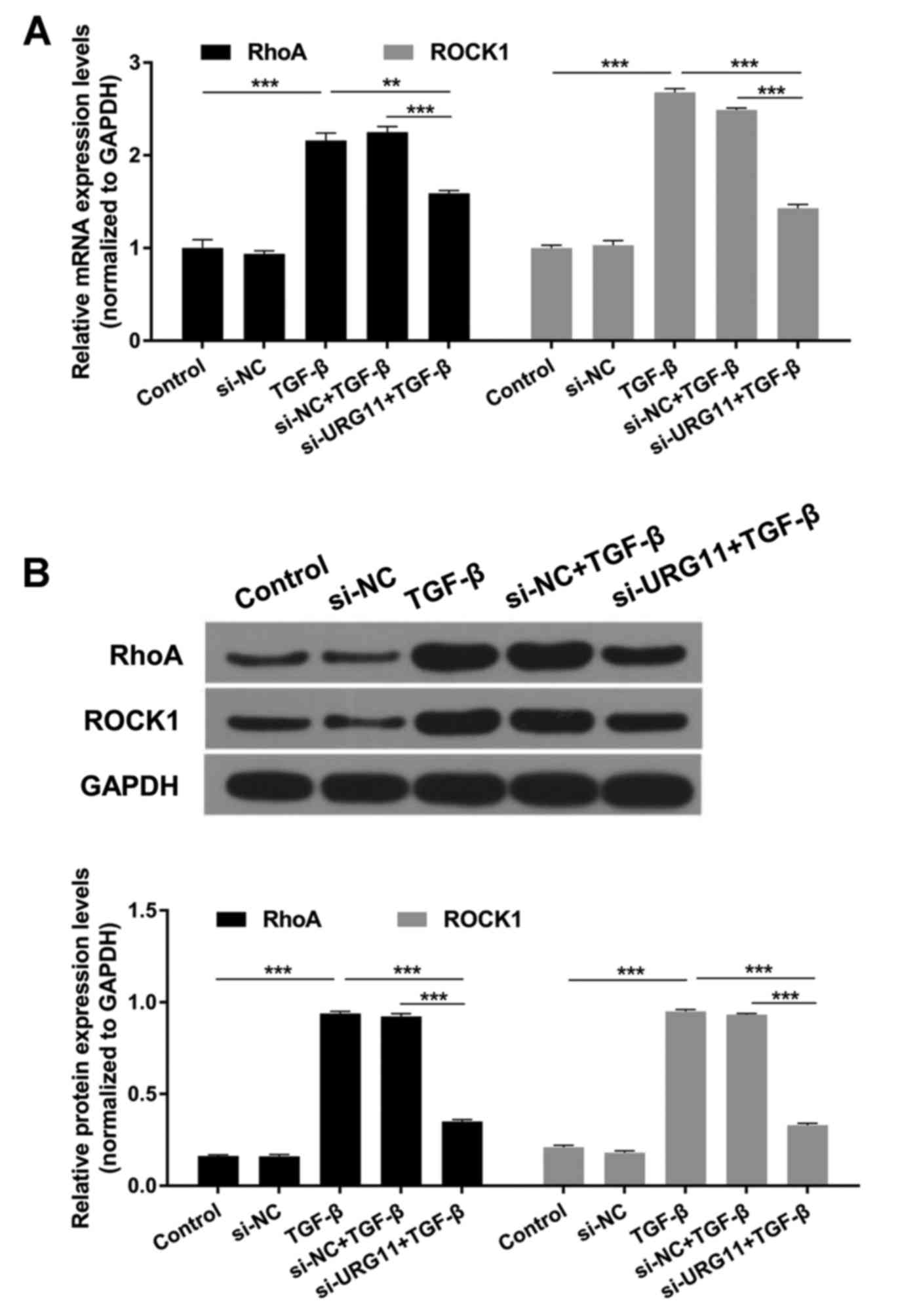Silencing of URG11 expression inhibits the proliferation and epithelial‑mesenchymal transition in benign prostatic hyperplasia cells via the RhoA/ROCK1 pathway
- Authors:
- Published online on: May 8, 2018 https://doi.org/10.3892/mmr.2018.8993
- Pages: 391-398
Abstract
Introduction
Benign prostatic hyperplasia (BPH) has become a common and frequently-occurring disease among elderly men worldwide, following the improvements in living standards and the prolongation of average life expectancies (1). Age, growth and testicular function have previously been revealed to affect the pathogenesis of BPH (2); however, its underlying mechanisms remain unclear. In recent years, the role of upregulated gene 11 (URG11; also termed von Willebrand factor C and EGF domain-containing protein) in the pathogenesis of BPH has gained increasing attention.
URG11 was initially identified as an upregulated gene in hepatitis B virus X protein (HBx)-positive HepG2 cells by polymerase chain reaction (PCR)-selected cDNA subtraction, and it has also been demonstrated that URG11 promotes the growth of hepatocellular carcinoma and tumorigenesis (3). URG11 encodes for a 70 kDa protein, which comprises of cysteine-rich and lectin domains (4). A further study revealed that lectin domains are closely associated with cell adhesion, matrix interaction, migration and invasion (5). Furthermore, it has previously been demonstrated that the expression of URG11 is enhanced in liver, thyroid, gastric and bladder cancer (3,4). In addition, a previous study revealed that URG11 is involved in the regulatory processes of cell growth, adhesion, migration and tumor metastasis (6). Furthermore, it has been demonstrated that URG11 is involved in epithelial-mesenchymal transition (EMT) via E-cadherin in the human proximal tubule cells (7). Therefore, URG11 may be an important gene in the progress of tumorigenesis and metastasis. However, the function and mechanism of URG11 in the pathogenesis and development of BPH have not yet been determined.
EMT refers to the transformation process whereby epithelial cells lose their polarity and move freely among the cell matrix with a mesenchymal cell phenotype (8). A previous study has demonstrated that within the patients with BPH, epithelial cells lose E-cadherin protein expression, get vimentin protein expression, which suggests that the development of BPH may be initiated from the dysregulation of prostate epithelial cells (9). Transforming growth factor-β (TGF-β) is a pleiotropic cytokine that is involved in cell reconstruction processes, such as cell proliferation, apoptosis, differentiation, migration and invasion (10). TGF-β is considered to have an important role in EMT (11). Despite the TGF-β signaling pathway being relatively simple, its regulatory mechanism is highly complex. Currently, the TGF-β signaling pathway and its associations with other signaling pathways has become an important research field.
The Ras protein family of guanosine triphosphates (GTPases) is comprised of numerous subfamilies. Ras family proteins include Rho, Rac1 and Cdc42 (12). Rho acts as a molecular switch in response to cytokines, G-protein coupled receptors, adhesion molecules and growth factor cell surface receptors by cycling between active GTP and inactive guanine diphosphate (13). Rho-associated protein kinase (ROCK)1 and ROCK2 protein kinases of the Rho protein family (14) that regulate actomyosin contractility via phosphorylation of the myosin light chain and inactivation of the myosin-binding subunit of myosin phosphatase (15). Furthermore, Ras homolog family member A (RhoA) and downstream target ROCK1 are involved in numerous biological and pathological processes, including cell adherence, apoptosis, proliferation and migration (16).
In the present study, the expression levels of URG11, RhoA and ROCK1 in patients with BPH, the effect of TGF-β on BPH-1 cells, and the roles of URG11 in BPH-1 cell proliferation, the cell cycle and EMT were investigated. In addition, the role of URG11 in BPH was investigated. The results of the present study suggest that URG11 may be a novel therapeutic target for the treatment of BPH.
Materials and methods
Clinical samples
A total of 5 ml of peripheral blood from 37 male patients (aged from 40–75 years old; mean, 52.3±3.6) with prostatic hyperplasia and the healthy prostate glands were collected from healthy volunteers (aged from 40–75 years old; mean, 49.9±5.2) at The First Affiliated Hospital of Xinxiang Medical University (Xinxiang, China) between July 2015 and June 2016. The participants who were diagnosed as BPH and willing to participate in the present study were enrolled. The exclusion criteria were as follows: Prostate carcinoma, bladder cancer, urethral stricture; cardiovascular, liver, kidney and hematopoietic disease and mental illness. Serums were separated by centrifugation (1,200 × g, 10 min, 4°C) 2 h following collection, and the supernatant serum was then frozen at −80°C until further analysis. The present study was approved by the Ethics Committee of The First Affiliated Hospital of Xinxiang Medical University, and written informed consent was obtained from all participants. No patients had undergone radiotherapy or chemotherapy prior to surgical resection.
Cell culture
Human BPH-1 cells (BPH epithelium) and normal prostate gland cells (RWPE-1) were obtained from the American Type Culture Collection (Manassas, VA, USA). Cells were cultured in RPMI-1640 medium (Invitrogen; Thermo Fisher Scientific, Inc., Waltham, MA, USA) with 10% fetal bovine serum (FBS; Hyclone; GE Healthcare Life Sciences, Logan, UT, USA), 100 U/ml penicillin and 100 mg/ml streptomycin (Invitrogen; Thermo Fisher Scientific, Inc.) in a humidified atmosphere at 37°C and 5% CO2. Cell morphology was then observed under a microscope (magnification, ×40).
TGF-β treatment
BPH-1 cells (5×104 cells/well) were seeded into 6-well plates with 2 ml serum-free medium and then incubated at 37°C for 8 h. Following this, cells were treated with 10 ng/ml TGF-β for 24 h.
Small interfering (si)RNA interference
Negative control siRNA (si-NC) and URG11 siRNA (si-URG11) were purchased from Shanghai GenePharma Co., Ltd. (Shanghai, China). The sequence of si-NC was 5′-UUCUCCGAACGUGUCACGU-3′, and the sequence of si-URG11 was 5′-CAGACGGAUUGCUGUACUU-3′. BPH-1 cells (2×104 cells/well) were seeded into 6-well plates and incubated at 37°C overnight. Following this, cells were transfected with si-NC (50 µM) and si-URG11 (50 µM) using Lipofectamine® 3000 (Invitrogen; Thermo Fisher Scientific, Inc.) according to the manufacturer's protocol. After 36 h post-transfection, the cells were collected to proceed with the subsequent experiments.
RNA extraction and reverse transcription-quantitative PCR (RT-qPCR)
Total RNA was extracted from the treated BPH-1 cells using the TRIzol reagent (Invitrogen; Thermo Fisher Scientific, Inc.). cDNA was synthesized from the extracted RNA using a reverse transcription kit, PrimeScript RT reagent kit (Takara Bio, Inc., Otsu, Japan) according to manufacturer's instructions. The reaction mixture was incubated at 37°C, 15 min, and reaction was inactivated at 85°C for 5 sec. Following this, qPCR was performed using SYBR Premix Ex Taq™ (Takara Bio, Inc.). The PCR thermocycling conditions were as follows: 95°C for 10 min, 35 cycles at 95°C for 15 sec and 60°C for 60 sec. Expression levels were quantified using the 2−ΔΔCq method (17). The primer sequences are presented in Table I.
Table I.Primer sequences used in reverse transcription-quantitative polymerase chain reaction assay. |
Western blotting
Cells were rinsed with PBS (cat. no. 37350; Stemcell Technologies, Inc., Beijing, China) and directly lysed in ice-cold radioimmunoprecipitation assay buffer (Beijing Solarbio Science & Technology, Beijing, China). Protein samples (20 mg) were then separated by performing 10% SDS-PAGE and then transferred onto polyvinylidene difluoride membranes. Membranes were then blocked with 5% bovine serum albumin (Sigma-Aldrich; Merck KGaA, Darmstadt, Germany; cat. no. A0281) at room temperature. After 2 h, membranes were then incubated with the following primary antibodies (all Abcam, Cambridge, UK) at 4°C overnight: Anti-URG11 [1:600 (3)], anti-cyclin D1 (1:10,000; cat. no. ab134175), anti-cyclin-dependent kinase inhibitor 1B (p27; 1:5,000; cat. no. ab32034), anti-E-cadherin (1:50; cat. no. ab1416), anti-N-cadherin (1:500; cat. no. ab18203), anti-vimentin (1:800; cat. no. ab8978), anti-RhoA (1:5,000; cat. no. ab187027), anti-ROCK1 (cat. no. ab45171, 1:200), anti-prostate specific antigen (PSA; 1:5,000; cat. no. ab182031) and anti-GAPDH (1:5,000; cat. no. ab8245). Following this, the membranes were incubated with an appropriate horseradish peroxidase-coupled secondary antibody at room temperature for 2 h (1:5,000; cat. no. ab6721, Abcam). Proteins were visualized on membranes using an enhanced chemiluminescent kit (Pierce; Thermo Fisher Scientific, Inc.) on the ODYSSEY Infrared Imaging System (LI-COR Biosciences, Lincoln, NE, USA). The data was then analyzed using Quantity One software version 4.6. (Bio-Rad Laboratories, Inc., Hercules, CA, USA). Protein expression levels were normalized to GAPDH.
Cell Counting Kit-8 (CCK-8) assay
Cells (2.5×104/ml) were collected with complete medium and seeded into 96-well plates in a 200 µl cell suspension. Following the transfection of cells according to the aforementioned protocol, CCK-8 reagent (Beyotime Institute of Biotechnology, Haimen, China; 15 µl/well) was added to the wells and incubated for 3 h at 37°C with 5% CO2. At days 1, 2, 3, 4 and 5 post-transfection, absorbance was then determined at 450 nm using an Elx800 Reader (Bio-Tek Instruments, Inc., Winooski, VT, USA).
Cell cycle assay
Treated cells were washed with PBS and then fixed with 70% ethanol for 30 min on ice. Following this, RNA was degraded with 20 mg/ml RNase (Sigma-Aldrich; Merck KGaA) for 1 h at 37°C. Cells were then labeled with 20 mg/ml propidium iodide (Sigma-Aldrich; Merck KGaA). Cell cycle images were obtained and analyzed using the FACSCalibur (BD Biosciences, Franklin Lakes, NJ, USA) flow cytometer and FlowJo software version 6.2.1 (FlowJo LLC, Ashland, OR, USA).
Statistical analysis
For statistical analyses between two groups, the Student's t-test was performed. For multiple comparisons, one-way analysis of variance followed by Turkey's post hoc test was performed. All statistical analyses were performed using IBM SPSS Statistics version 21 (IBM Corp., Armonk, NY, USA) software, and all data are presented as the mean ± standard deviation. P<0.05 was considered to indicate a statistically significant difference.
Results
URG11, RhoA and ROCK1 are highly expressed in patients with BPH
The results of the present study revealed that URG11 expression was markedly higher in serum from patients with prostatic hyperplasia compared with in the healthy controls (n=37; P=0.0013; Fig. 1A). The expression of RhoA was also significantly upregulated in the serum of patients with BPH compared with the controls (n=37; P=0.0073; Fig. 1B). In addition, ROCK1 expression was also significantly increased in the serum of patients with prostatic hyperplasia compared with healthy controls (n=37; P=0.0011; Fig. 1C). The relative expression levels of URG11, RhoA and ROCK1 were presented in Fig. 1D.
URG11 expression is silenced in BPH-1 cells
BPH-1 cells were cultured in RPMI-1640 medium with 10% FBS at 37°C for 48 h and then observed under a light microscope. Cells grew adhering to the wall of the culture dish, exhibited rectangular or irregular polygon shapes, had large and round nuclei, and grew in close contact and irregular arrangements. These characteristics demonstrated that the cells exhibited typical epithelial cell morphology (Fig. 2A). To further investigate this, the expression levels of PSA in cells were determined. The results demonstrated that the expression level of PSA was significantly enhanced in BPH-1 cells compared with normal prostate gland cells (Fig. 2B and C). Thus, it was confirmed that the obtained cells were BPH-1 cells. Furthermore, the expression level of URG11 in normal prostate gland cells and BPH-1 cells was investigated. The results revealed that the expression levels of URG11 were significantly enhanced in BHP-1 cells compared with normal prostate gland cells (Fig. 2B and C). To further investigate the potential roles of URG11 on BPH-1 cell proliferation and migration, BPH-1 cells were either treated with PBS (control), or transfected with si-NC or si-URG11. RT-qPCR and western blot assays were used to detect the expression level of URG11. The results demonstrated that URG11 expression was significantly suppressed in BPH-1 cells transfected with si-URG11 compared with the si-NC group (Fig. 2D and E; P<0.001). These results revealed that the efficiency and specificity of URG11 knockdown were high.
Decreased expression of URG11 suppresses proliferation and induces cell cycle arrest of BPH-1 cells, regulated by TGF-β
Previous studies have demonstrated that TGF-β enhances cancer progression by inducing EMT (18). To investigate this further, BPH-1 cells were treated with either PBS (control) or TGF-β (5 ng/ml for 8 h), or transfected with si-NC or si-URG11 and treated with TGF-β. RT-qPCR analyses revealed that treatment with TGF-β significantly enhanced URG11 expression, and that transfection with si-URG11 significantly reversed this increase induced by TGF-β (Fig. 3A; P<0.001). The CCK-8 assay results demonstrated that TGF-β significantly increased the proliferation of BPH-1 cells, and transfection with si-URG11 significantly suppressed BPH-1 cell proliferation induced by TGF-β (Fig. 3B; P<0.01 or P<0.001). In addition, the potential mechanism underlying TGF-β and URG11-mediated changes in BPH-1 cell proliferation was further investigated using flow cytometry. The results revealed that the proportion of cells in the G1 phase was significantly increased in the TGF-β group compared with the control group, and was significantly decreased in si-URG11 + TGF-β group compared with the si-NC + TGF-β group. The proportion of cells in the G2 phase was decreased in the TGF-β group compared with control group, and was significantly increased in the si-URG11 + TGF-β group compared with the si-NC + TGF-β group (Fig. 3C; P<0.05, P<0.01 or P<0.001), suggesting that the downregulation of URG11 promoted the cell cycle arrest.
Silencing of URG11 downregulates the TGF-β-induced expression levels of cyclin D1, N-cadherin and vimentin, and upregulates the expression levels of p27 and E-cadherin
According to the aforementioned results, silencing of URG11 induced cell cycle arrest. The effect of URG11 on cyclin D1 and p27 expression was investigated further, as these proteins are associated with the cell cycle, and it was revealed that TGF-β enhanced cyclin D1 expression and suppressed p27 expression; however, transfection with si-URG11 reversed these effects in BPH-1 cells (Fig. 4; P<0.01 or P<0.001). In addition, the effect of URG11 on N-cadherin, vimentin and E-cadherin expression levels was investigated, as these proteins are associated with EMT, and it was revealed that treatment with TGF-β enhanced the expression levels of N-cadherin and vimentin, and decreased the expression level of E-cadherin (Fig. 4; P<0.01 or P<0.001). Suppression of URG11 expression via transfection with si-URG11 significantly reversed these effects on BPH-1 cells (Fig. 4; P<0.01 or P<0.001).
Suppression of URG11 expression decreases TGF-β-induced RhoA and ROCK1 expression levels
Studies revealed that RhoA and ROCK1 are downstream targets of TGF-β signaling and are involved in cell proliferation, migration and apoptosis processes (19–22). In the present study, it was revealed that RhoA and ROCK1 expression levels were significantly increased by TGF-β compared with the control group, and significantly decreased in the si-URG11 + TGF-β group compared with the si-NC + TGF-β group (Fig. 5; P<0.01 or P<0.001).
Discussion
BPH is one of the most prevalent diseases of the urinary system that affects elderly men. The major clinical manifestations of BPH include frequent urination, urgent urination and dysuria (23). Currently, population aging is a major public health problem, particularly in China. With the aging population, the incidence of BPH is expected to increase further and thus seriously affect the quality of life of older men, and may even result in the emergence of serious complications (24,25).
URG11 is an HBx-upregulated gene and regulates HBx-mediated hepatocarcinoma development (26). A previous study demonstrated that silencing of URG11 expression suppresses gastric cancer cell proliferation, adhesion, invasion and metastasis abilities, and prevents cell transition from G1 phase to S phase in vitro (6). Furthermore, previous studies have revealed that knockdown of URG11 suppresses lung cancer proliferation and invasion via β-catenin (27) and induces EMT via E-cadherin and β-catenin; and overexpression of URG11 enhances hepatocellular carcinoma growth (4). These results suggest that URG11 may regulate tumor progression via regulation of EMT and the β-catenin signaling pathway. However, the function and underlying mechanisms of URG11 in BPH have not yet been determined. In the present study, it was revealed that the expression of URG11 was significantly enhanced in patients with BPH compared with matched controls, and that decreased URG11 expression suppressed BPH-1 cell proliferation and induced cycle arrest via regulation of cyclin D1 and p27 expression levels.
EMT is an essential early step and a critical process in tumor metastasis (28). During EMT, tumor cells lose their epithelial characteristics, including cell-cell adhesion and polarity, and obtain mesenchymal-like phenotypes (29). Furthermore, phenotypic markers commonly change during EMT, for example, the epithelial cell phenotypic marker E-cadherin is downregulated and mesenchymal cell phenotypic markers, N-cadherin and vimentin, are upregulated post-EMT (30). Previous studies have demonstrated that URG11 is associated with E-cadherin expression (31,32). E-cadherin, an epithelial cell adhesion protein, is important for the formation and maintenance of embryonic epithelial cells (33). In addition, E-cadherin is important for the maintenance of structural integrity and cell polarity (34). In the present study, it was demonstrated that suppression of URG11 expression significantly enhances E-cadherin expression, and significantly suppresses the expression of N-cadherin and vimentin. TGF-β is a multifunctional protein of the TGF-β protein superfamily and regulates the growth, differentiation, apoptosis and immunity of numerous cell types (35). Previous studies have demonstrated that TGF-β functions as an inducer of EMT and is closely associated with cancer progression, angiogenesis, pathological staging and prognosis (18,36). Thus, the results suggested that silencing of URG11 suppresses EMT progress in BPH.
Rho proteins have GTPase activity and are involved in cell division and proliferation (37). RhoA, an important member of the Rho family, regulates numerous downstream genes, alters actin structure and morphology and regulates cell proliferation, apoptosis, metastasis and other biological processes (38). A recent study demonstrated that ROCK, an important RhoA regulator, is associated with cell apoptosis, EMT, migration and metastasis (39). In the present study, it was revealed that knockdown of URG11 suppresses TGF-β-induced RhoA and ROCK1 expression levels, indicating that URG11 regulates BPH progression via the RhoA/ROCK1 signaling pathway.
In conclusion, the results of the present study revealed that URG11, RhoA and ROCK1 expression levels were enhanced in patients with PBH. Additionally, suppression of URG11 expression inhibited TGF-β-regulated BPH-1 cell proliferation and induced cell cycle arrest via the regulation of cell cycle-associated genes (cyclin D1 and p27). Furthermore, URG11 knockdown suppressed TGF-β-mediated EMT of BPH-1 cells. In addition, silencing of URG11 expression significantly decreased RhoA and ROCK1 expression levels regulated by TGF-β. Therefore, URG11 may represent a novel prognostic marker and candidate drug target for the treatment of BPH.
Acknowledgements
Not applicable.
Funding
No funding was received.
Availability of data and materials
All data generated or analyzed during this study are included in this published article.
Authors' contributions
GZ wrote the main manuscript. FZ, GH and ZL performed the experiments. GZ and JL designed the study. QY and ZHL performed data analysis. GZ, FZ and JL contributed to manuscript revisions and all authors reviewed the manuscript.
Ethics approval and consent to participate
The present study was approved by the Ethics Committee of The First Affiliated Hospital of Xinxiang Medical University (Xinxiang, China), and written informed consent was obtained from all participants.
Consent for publication
Not applicable.
Competing interests
The authors declare that they have no competing interests.
References
|
Mobley D, Feibus A and Baum N: Benign prostatic hyperplasia and urinary symptoms: Evaluation and treatment. Postgrad Med. 127:301–307. 2015. View Article : Google Scholar : PubMed/NCBI | |
|
Corona G, Vignozzi L, Rastrelli G, Lotti F, Cipriani S and Maggi M: Benign prostatic hyperplasia: A new metabolic disease of the aging male and its correlation with sexual dysfunctions. Int J Endocrinol. 2014:3294562014. View Article : Google Scholar : PubMed/NCBI | |
|
Lian Z, Liu J, Li L, Li X, Clayton M, Wu MC, Wang HY, Arbuthnot P, Kew M, Fan D and Feitelson MA: Enhanced cell survival of Hep3B cells by the hepatitis B × antigen effector, URG11, is associated with upregulation of beta-catenin. Hepatology. 43:415–424. 2006. View Article : Google Scholar : PubMed/NCBI | |
|
Xie H and Liu J: Increased expression URG11 in hepatocellular carcinoma tissues promotes the growth of hepatocellular carcinoma cells. Xi Bao Yu Fen Zi Mian Yi Xue Za Zhi. 31:1523–1527. 2015.(In Chinese). PubMed/NCBI | |
|
Zou X, Li X, Liu J, Lian Z, Fan R, Du R, Xie H, Song J and Fan D: Preparation and characterization of a specific monoclonal antibody against a new gene product: URG11. Hybridoma (Larchmt). 25:378–381. 2006. View Article : Google Scholar : PubMed/NCBI | |
|
Du R, Xia L, Sun S, Lian Z, Zou X, Gao J, Xie H, Fan R, Song J, Li X, et al: URG11 promotes gastric cancer growth and invasion by activation of beta-catenin signalling pathway. J Cell Mol Med. 14:621–635. 2010.PubMed/NCBI | |
|
Du R, Huang C, Bi Q, Zhai Y, Xia L, Liu J, Sun S and Fan D: URG11 mediates hypoxia-induced epithelial-to-mesenchymal transition by modulation of E-cadherin and beta-catenin. Biochem Biophys Res Commun. 391:135–141. 2010. View Article : Google Scholar : PubMed/NCBI | |
|
Lamouille S, Xu J and Derynck R: Molecular mechanisms of epithelial-mesenchymal transition. Nat Rev Mol Cell Biol. 15:178–196. 2014. View Article : Google Scholar : PubMed/NCBI | |
|
Shao R, Shi J, Liu H, Shi X, Du X, Klocker H, Lee C, Zhu Y and Zhang J: Epithelial-to-mesenchymal transition and estrogen receptor alpha mediated epithelial dedifferentiation mark the development of benign prostatic hyperplasia. Prostate. 74:970–982. 2014. View Article : Google Scholar : PubMed/NCBI | |
|
Syed V: TGF-β signaling in cancer. J Cell Biochem. 117:1279–1287. 2016. View Article : Google Scholar : PubMed/NCBI | |
|
Katsuno Y, Lamouille S and Derynck R: TGF-β signaling and epithelial-mesenchymal transition in cancer progression. Curr Opin Oncol. 25:76–84. 2013. View Article : Google Scholar : PubMed/NCBI | |
|
Chew TW, Liu XJ, Liu L, Spitsbergen JM, Gong Z and Low BC: Crosstalk of ras and rho: Activation of RhoA abates Kras-induced liver tumorigenesis in transgenic zebrafish models. Oncogene. 33:2717–2727. 2014. View Article : Google Scholar : PubMed/NCBI | |
|
Bryan BA, Dennstedt E, Mitchell DC, Walshe TE, Noma K, Loureiro R, Saint-Geniez M, Campaigniac JP, Liao JK and D'Amore PA: RhoA/ROCK signaling is essential for multiple aspects of VEGF-mediated angiogenesis. FASEB J. 24:3186–3195. 2010. View Article : Google Scholar : PubMed/NCBI | |
|
Riou P, Kjær S, Garg R, Purkiss A, George R, Cain RJ, Bineva G, Reymond N, McColl B, Thompson AJ, et al: 14-3-3 proteins interact with a hybrid prenyl-phosphorylation motif to inhibit G proteins. Cell. 153:640–653. 2013. View Article : Google Scholar : PubMed/NCBI | |
|
Zhao ZS and Manser E: PAK and other Rho-associated kinases-effectors with surprisingly diverse mechanisms of regulation. Biochem J. 386:201–214. 2005. View Article : Google Scholar : PubMed/NCBI | |
|
Chan CH, Lee SW, Li CF, Wang J, Yang WL, Wu CY, Wu J, Nakayama KI, Kang HY, Huang HY, et al: Deciphering the transcriptional complex critical for RhoA gene expression and cancer metastasis. Nat Cell Biol. 12:457–467. 2010. View Article : Google Scholar : PubMed/NCBI | |
|
Livak KJ and Schmittgen TD: Analysis of relative gene expression data using real-time quantitative PCR and the 2(-Delta Delta C(T)) method. Methods. 25:402–408. 2001. View Article : Google Scholar : PubMed/NCBI | |
|
Wendt MK, Tian M and Schiemann WP: Deconstructing the mechanisms and consequences of TGF-β-induced EMT during cancer progression. Cell Tissue Res. 347:85–101. 2012. View Article : Google Scholar : PubMed/NCBI | |
|
Riento K and Ridley AJ: Rocks: Multifunctional kinases in cell behaviour. Nat Rev Mol Cell Biol. 4:446–456. 2003. View Article : Google Scholar : PubMed/NCBI | |
|
Hu B, Xu C, Cao P, Tian Y, Zhang Y, Shi C, Xu J, Yuan W and Chen H: TGF-β stimulates expression of chondroitin polymerizing factor in nucleus pulposus cells through the Smad3, RhoA/ROCK1 and MAPK signaling pathways. J Cell Biochem. 119:566–579. 2018. View Article : Google Scholar : PubMed/NCBI | |
|
Wu ML, Chen CH, Lin YT, Jheng YJ, Ho YC, Yang LT, Chen L, Layne MD and Yet SF: Divergent signaling pathways cooperatively regulate TGFβ induction of cysteine-rich protein 2 in vascular smooth muscle cells. Cell Commun Signal. 12:222014. View Article : Google Scholar : PubMed/NCBI | |
|
Mohamed JS and Boriek AM: Stretch augments TGF-beta1 expression through RhoA/ROCK1/2, PTK, and PI3K in airway smooth muscle cells. Am J Physiol Lung Cell Mol Physiol. 299:L413–L424. 2010. View Article : Google Scholar : PubMed/NCBI | |
|
Bechis SK, Otsetov AG, Ge R and Olumi AF: Personalized medicine for the management of benign prostatic hyperplasia. J Urol. 192:16–23. 2014. View Article : Google Scholar : PubMed/NCBI | |
|
Dong X, Chang ES, Zeng P and Simon MA: Suicide in the global chinese aging population: A review of risk and protective factors, consequences, and interventions. Aging Dis. 6:121–130. 2015. View Article : Google Scholar : PubMed/NCBI | |
|
Wang W, Guo Y, Zhang D, Tian Y and Zhang X: The prevalence of benign prostatic hyperplasia in mainland China: Evidence from epidemiological surveys. Sci Rep. 5:135462015. View Article : Google Scholar : PubMed/NCBI | |
|
Lian Z, Liu J, Li L, Li X, Tufan NL, Clayton M, Wu MC, Wang HY, Arbuthnot P, Kew M and Feitelson MA: Upregulated expression of a unique gene by hepatitis B × antigen promotes hepatocellular growth and tumorigenesis. Neoplasia. 5:229–244. 2003. View Article : Google Scholar : PubMed/NCBI | |
|
Liu ZL, Wu J, Wang LX, Yang JF, Xiao GM, Sun HP and Chen YJ: Knockdown of upregulated gene 11 (URG11) inhibits proliferation, invasion, and β-catenin expression in Non-small cell lung cancer cells. Oncol Res. 24:197–204. 2016. View Article : Google Scholar : PubMed/NCBI | |
|
Davis FM, Stewart TA, Thompson EW and Monteith GR: Targeting EMT in cancer: Opportunities for pharmacological intervention. Trends Pharmacol Sci. 35:479–488. 2014. View Article : Google Scholar : PubMed/NCBI | |
|
Hyun KA, Koo GB, Han H, Sohn J, Choi W, Kim SI, Jung HI and Kim YS: Epithelial-to-mesenchymal transition leads to loss of EpCAM and different physical properties in circulating tumor cells from metastatic breast cancer. Oncotarget. 7:24677–24687. 2016. View Article : Google Scholar : PubMed/NCBI | |
|
Nijkamp MM, Span PN, Hoogsteen IJ, van der Kogel AJ, Kaanders JH and Bussink J: Expression of E-cadherin and vimentin correlates with metastasis formation in head and neck squamous cell carcinoma patients. Radiother Oncol. 99:344–348. 2011. View Article : Google Scholar : PubMed/NCBI | |
|
Liu J, Lian Z, Han S, Waye MM, Wang H, Wu MC, Wu K, Ding J, Arbuthnot P, Kew M, et al: Downregulation of E-cadherin by hepatitis B virus X antigen in hepatocellullar carcinoma. Oncogene. 25:1008–1017. 2006. View Article : Google Scholar : PubMed/NCBI | |
|
Arzumanyan A, Friedman T, Kotei E, Ng IO, Lian Z and Feitelson MA: Epigenetic repression of E-cadherin expression by hepatitis B virus × Antigen in liver cancer. Oncogene. 31:563–572. 2012. View Article : Google Scholar : PubMed/NCBI | |
|
Riethmacher D, Brinkmann V and Birchmeier C: A targeted mutation in the mouse E-cadherin gene results in defective preimplantation development. Proc Natl Acad Sci USA. 92:855–859. 1995. View Article : Google Scholar : PubMed/NCBI | |
|
Huber MA, Kraut N and Beug H: Molecular requirements for epithelial-mesenchymal transition during tumor progression. Curr Opin Cell Biol. 17:548–558. 2005. View Article : Google Scholar : PubMed/NCBI | |
|
Talar B and Czyz M: TGF-β signaling pathways in cancers. Postepy Hig Med Dosw (Online). 67:1008–1017. 2013.(In Polish). View Article : Google Scholar : PubMed/NCBI | |
|
Gao J, Zhu Y, Nilsson M and Sundfeldt K: TGF-β isoforms induce EMT independent migration of ovarian cancer cells. Cancer Cell Int. 14:722014. View Article : Google Scholar : PubMed/NCBI | |
|
Surma M, Wei L and Shi J: Rho kinase as a therapeutic target in cardiovascular disease. Future Cardiol. 7:657–671. 2011. View Article : Google Scholar : PubMed/NCBI | |
|
Marjoram RJ, Lessey EC and Burridge K: Regulation of RhoA activity by adhesion molecules and mechanotransduction. Curr Mol Med. 14:199–208. 2014. View Article : Google Scholar : PubMed/NCBI | |
|
Lotz-Jenne C, Lüthi U, Ackerknecht S, Lehembre F, Fink T, Stritt M, Wirth M, Pavan S, Bill R, Regenass U, et al: A high-content EMT screen identifies multiple receptor tyrosine kinase inhibitors with activity on TGFβ receptor. Oncotarget. 7:25983–26002. 2016. View Article : Google Scholar : PubMed/NCBI |



